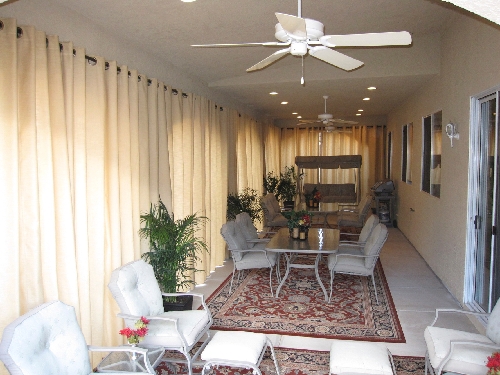Drapery warms up patio – literally and figuratively
Autumn in the desert has wonderful advantages. Although we don't have the beautiful changing colors that our Northern states enjoy, we benefit from mild and accommodating weather. It's a great time to enjoy your patio.
Decorating a patio can provide more space for relaxing or socializing. Many times designers talk about bringing the outside in but today I'd like to tell you about moving the inside out.
By adding a few items that are usually considered interior specific, you can expand your living space and utilize a once-forgotten outdoor space.
The featured tract home patio is done quite simply, showing what can be done on a small budget. With a larger budget you can take it to the next level by adding more substantial furniture, built-in seating and a patio fireplace and/or a fire-pit.
Outdoor fabrics, like outdoor furniture, are specially made to handle the harsh elements. Fabrics are treated with a waterproofing and/or a fungicidal to prevent mold and mildew. You can purchase fabrics that are already treated or have it applied after you purchase it. Although there isn't a humidity problem here in the desert, there is an occasional rainfall with gusty winds that could potentially stain an untreated fabric. Treated fabric has a crisp feel that hangs nicely, making the draperies easy to manipulate.
Patio draperies can be functional and/or purely decorative. They can be done on the cheap or can get quite costly. The least expensive way to create an impression is to use accent panels -- panels that do not move. They are hung on small rods, saving you money on hardware, fabric, labor and installation. If you want the draperies to close, it starts to get more expensive.
Outdoor draperies are usually made with grommets, a ring that is permanently inserted into a hole in fabric, instead of pleats. The rod is threaded through the grommets, holding the draperies on the rod, even during high winds. Standard pleats would collect a lot of dust and would provide a convenient home to unwanted, tiny outdoor creatures.
The pictured patio draperies were made to close and break a mild breeze. A chained weight is sewn into the hem and runs the full width of the draperies. The weighted chain stabilizes the fabric, but it won't be enough to stop the wind during a mighty windstorm. That's when the tie-bands come in handy. On a windy day, the draperies can be secured to the posts.
When purchasing drapery rods that will be used outside, be sure to tell your vendor where you plan to use them. For longevity, they should be powder-coated to survive the summer heat and to keep them from rusting.
As the installer was hanging these patio draperies, the patio began to transform into a warm and livable space. The once-abrasive stucco was softened by folds of fabric, which seemed to invite you out to enjoy the new outside room.
Although the desire for patio draperies was the catalyst that started this patio transformation, the space didn't feel balanced until a few more items were added. As much as the draperies served to soften the feel and provide warmth during a cool breeze, the brilliant colors of the area rugs introduced a new focal point. The plants provided a visual transition from the colorful rugs to the soft draperies and completed the look.
This simple patio makeover now provides an extra outdoor room for guests to gather, even if the wind wants to blow (a little).
Note: The fabric and rugs in these pictures were purchased from one of our local stores: Home Fabrics. The staff was accommodating .
Cindy Payne is a certified interior designer with more than 25 years of experience, a member of the American Society of Interior Designers, as well as a licensed contractor. E-mail questions to her at deardesigner@ projectdesigninteriors.com or send them to her at Project Design Interiors, 2620 S. Maryland Parkway, Suite 189, Las Vegas, NV 89109. She can be reached online at www.projectdesigninteriors.com.



















